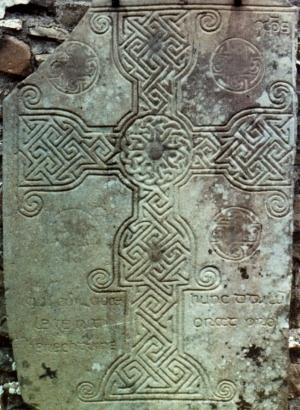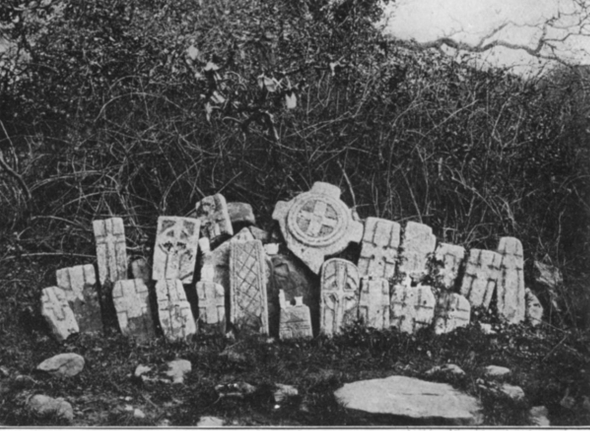The 18th of February is the feast day of St Berrihert/Berrahert of the parish of Ardane, Co Tipperary. An Anglo-Saxon saint, he is traditionally believed to have come to Ireland in the seventh century following the Synod of Whitby. To mark the saint’s feast this two-part blog post will explore the archaeological remains and the evidence pilgrimage at a site associated with the site, known as St Berrihert’s Kyle in Co Tipperary.
Location
St Berrihert’s Kyle is one of Tipperary’s best hidden treasure. The site is located in the townland of Ardane, in the parish of Templeneiry. It is difficult to find as there is no signposting. It is located close to the village of Ardane.
From the main road, you will see a sign for “Golden Mile, Winner 2003”, turn left on the opposite road. Half a mile down this road is a gate with a no parking sign. Go through this gate and cross the first field (Be aware that there might be cows or bulls!). From there you will find the wooden trail that will lead you to the Kyle and the Well (visitballyhoura.com).
Who is St Berrihert?
It is suggested that St Berrihert came to Ireland following the Synod of Whitby (Ó HÉaildhe 1967, 104). He is named in some documents as brother of the Saxon saint Garailt of Mayo (Ó Riain 2011, 103). He is associated with a number of places in the south of Ireland mainly around Co Cork. He is likely also to be the same saint as St Berichter the patron of an early medieval ecclesiastical site at Tullylease in the barony of Duhallow, Co Cork. An interesting cross slab of 8th/9th century date survives at Tullylease. The stone has an elaborate decorated cross and the text of with a prayer for Beirchachtuire an Irish version of the Anglo-Saxon Beorhtwine.

Tullylease Cross slab. Image taken from http://www.irishmegaliths.org.uk/crosspillars2.htm
The Annals of the Four Masters records the death of a cleric with this name at the site in 839,
Berichtir of Tulach Leis died on the 6th of December.
The Martyrologies of Donegal and Gorman record the saint feast day as the 6th of December. His feast was honoured on the 18th of February at St Berrihert’s Kyle, the subject of this post, and at the 15th of February in West Kerry. The variation of feast day perhaps indicates ‘ that the cult had become entwined with that of Bearach of Termonbarry‘ whose feast is on the 15th of February (Ó Riain 2011, 102).
St Berrihert’s Kyle
St Berrihert’s Kyle is located on farm land. To approach the site you must cross through two fields. The land is boggy but a timber path marks the way. There are often horses or cattle in the field.
The Kyle through the years
The Kyle is the oval area enclosed by an earthen bank and contains a large number of early medieval cross slabs. The landscape of this area has changed in the last 100 years or so.
In 1907 Crawford described the area as ‘a circular enclosure in a field west of the well and greatly overgrown with oak tress and thorn bushes‘. He also noted that all the carved stones, which he counted 22 have been collected and built into a station (Crawford 1907, 61).
The photo above dates to 1907, it shows the site as very overgrown with a large number of the cross slabs placed in front of a small tree covered in rags. Crawford( 1907, 62) mentions the tree was a thorn-bush and that a series of offerings were left here including statuettes, vases, cups and toy-teapots.
A second photo from the Limerick City Museum collection show that the cross slabs had been moved and built up into a station in front of a wall. A large rectangular stone was placed in front of the crosses . This photo is dated to between 1896-1910 and on the reverse image in pencil ‘Berrihert’s Kyle Co. Tipp. 1936’.

Photo of Crosses at St Berrihert’s Kyle dated 1936 ( from http://museum.limerick.ie/index.php/Detail/Object/Show/object_id/8087)
The site today
Today the landscape of the site owes much to work carried out in 1946 by the Office of Public Works/OPW who “cleaned up the site”. They cleared the enclosure of bushes and vegetation. Then they collected all the crosses and built them into a circular stone structure which incorporates a large oak tree, to protect the crosses from cattle at the south end of the site. The walls are full of cross slabs and it has an ancient look to it.
The stone structure is entered via a style, beside a large oak tree. Ó HÉailidhe (1967, 103) recorded 72 cross inscribed stone at the site but only 67 were noted by the Tipperary Survey in 2011 suggesting some may be missing.
The majority of the crosses depict a simple Latin cross on a single face. A small number have decoration on both faces.
A larger rectangular stone with one hollow depression is found within the stone enclosure, in front of the head of a high cross which is incorporated into the wall. The surface of the bullaun stone is covered by trinkets left by pilgrims and includes holy statues, small toys, coins and crystals .
A large egg-shaped stone sits in the hollow of the bullaun stone. These egg stones occurs at other pilgrim sites and are known as cursing stones.
A holly tree within the enclosure is covered rags and ribbons tied by modern pilgrims.
The presence of such a large number of cross slabs at the site may suggest the presence of a monastic settlement. There are no upstanding remains of any buildings at the site. If this was a monastic site it is possible the buildings were built of wood. In the 1940’s the ground surface of the Kyle was lowered and the soil from this area was used to build a causeway across the bog to the nearby St Berrihert’s well. The OPW recorded no trace of walls when lowering the ground level at the site. It is impossible to know what damage this act did to any sub-surface archaeological remains that may have been present.
Around the edge of the Kyle are a number of small stone cairns surmounted by a cross slab. These cairns were created in 1940’s to mark stations of the cross but there were not part of the original pilgrim stations at the site .
The central area of the Kyle is defined by stone curbing which demarcate a children’s burial ground.
St Berrihert’s holy well
The nearby holy well is dedicated to St Berrihert and is located a short distance from the Kyle. The path is marked by a timber track through marshy ground.
The path continues crossing over a small bridge.
The well is a large circular pool is found in a surrounded by trees and defined by an earthen bank in the NE-NW.
Some of the trees are decorated offering left by modern pilgrims and range from ribbons, rags, socks and toys.
The well is formed from limestone springs and the waters bubble forth giving it a really magical appearance. This was very likely a place of prehistoric pilgrimage.
Coming soon is part II of this post, which will look at the history of pilgrimage at the site.
References
Crawford, H. S. 1907. ‘A descriptive list of the early Irish crosses’, JRSAI 37, 187-239.
ÓHÉailidhe, P. 1967. ‘The crosses and slabs at St Berrihert’s Kyle in the Glen of Aherlow’ in Rynne, E. North Munster Studies. Limerick: The Thomond Archaeology Society, 102-126.
1987.0727, Limerick Museum Catalogue, http://museum.limerick.ie/index.php/Detail/Object/Show/object_id/8087http://museum.limerick.ie/index.php/Detail/Object/Show/object_id/8087
















Very good = any word around Tipperary on the meaning of “Kyle” and possible related word of “Okyle”.
Very good = any word around Tipperary on the meaning of the word “Kyle” and possible related word of “Okyle”?
Thanks Niall its likely a corruption of the Irish words Cill or Coill
Thanks Louise, Saw one or two places in Kerry with the word “kyle” in the place name while looking for something else. A wood. Nice
What a great site. Loved your photos and your account of the site.
Reblogged this on seamussweeney and commented:
This is the Eve of St Berrihert. If that doesn’t mean anything to you (and it didn’t to me), take a read of this blog post. I am embarrassed to say I had not heard of this place until about ten minutes ago, and I live about thirty minutes drive away.
Thank you lots great sites around that area
Excellent writeup. Live about 10mins from here. Only discovered it about 10 yrs ago. Thanks for the info. A real hidden gem!
Thanks Eimear its such a special place your so lucky to live so close to it. Louise
[…] in an out of the way grove of trees on private land. In appearance it is very like the holy well at St Berriherts Kyle but more […]